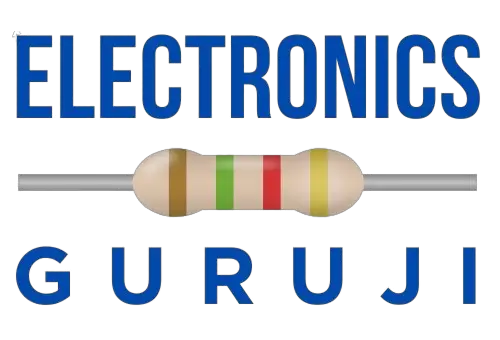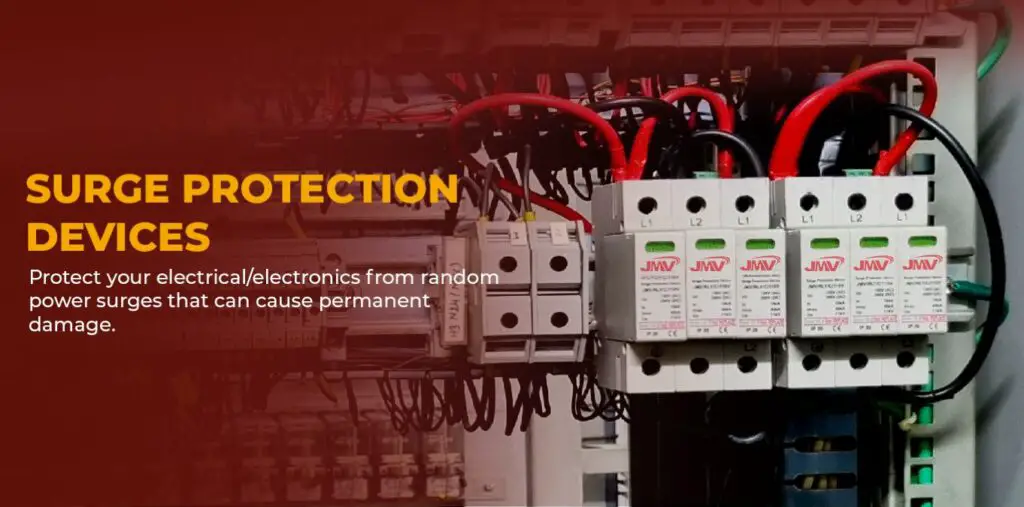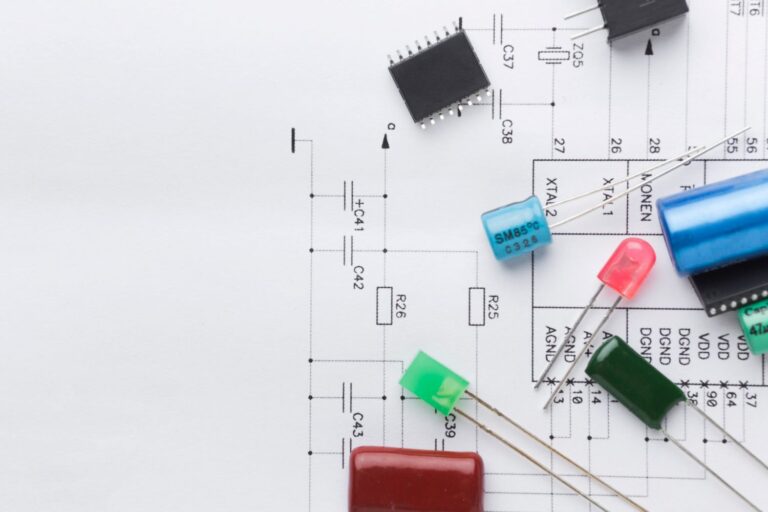When we talk about the safe and robust electrical systems, the significance of surge protective device (SPD) cannot be overstated. This device, meticulously engineered, serve as the vanguard against transient voltage spikes, shielding sophisticated electronic systems from potential harm. Let’s explore the basics of the SPD device, its working, applications, and understanding the critical elements from the design point of view.
Page Contents
What is a Surge Protective Device?
A surge protective device, is an electronic device designed to safeguard electrical systems from sudden increases in voltage, known as voltage surges or spikes. This device is engineered to swiftly detect these surges and redirect the excess voltage away from sensitive equipment, preventing damage or malfunctioning of electronic devices and systems.
Components of a Surge Protective Device
A Surge protective device consists of various types of components to accomplish proper protection from surges as described below:
- Metal Oxide Varistors (MOVs): These are semiconductors with nonlinear voltage-current characteristics. MOVs act as the primary surge absorbing elements within SPDs, swiftly diverting excess voltage to the ground when a surge occurs.
- Gas Discharge Tubes (GDTs): GDTs are gas-filled tubes that trigger at specific voltage thresholds. They provide an alternate path for surge currents, protecting the connected equipment by conducting the excessive energy away from sensitive circuits.
- Silicon Avalanche Diodes (SADs): SADs are semiconductor devices designed to handle transient voltage spikes. Similar to MOVs, they aid in clamping excess voltage, redirecting it to ground, and safeguarding the system against surges.
- Thermal Disconnection Elements: These elements serve as safety measures within SPDs. In the event of prolonged or extreme surges, thermal disconnectors can isolate the SPD from the power supply, preventing damage to the connected equipment.
- Internal Fuses or Overcurrent Protection: Some SPD designs incorporate internal fuses or overcurrent protection mechanisms. These components act as fail-safes, interrupting the circuit in cases of extreme overload or sustained surges to prevent damage to the SPD itself.
- Enclosure and Mounting System: The enclosure housing the components provides physical protection and insulation. Additionally, the mounting system ensures proper installation and grounding, optimizing the SPD’s effectiveness.
- Indicator Lights or Alarms: Many modern SPDs feature indicator lights or alarms to signal their operational status. These visual or audible cues inform users about the SPD’s health and functionality.
Operating Principles of a Surge Protective Device
A Surge Protective Devices (SPD) operates on the principle of diverting excess voltage away from sensitive electronic equipment during surge events. Its functionality involves several key mechanisms:
- Voltage Diversion: When a surge occurs, the SPD swiftly detects the elevated voltage and provides a low-impedance path to divert the excess energy to the ground. This redirection prevents the excessive voltage from reaching and damaging connected devices.
- Component Action: SPDs utilize components like Metal Oxide Varistors (MOVs), Gas Discharge Tubes (GDTs), or Silicon Avalanche Diodes (SADs). These components exhibit nonlinear characteristics, allowing them to effectively absorb and dissipate the surge energy, protecting the equipment downstream.
- Fast Response: SPDs are designed to respond rapidly to surges. Their quick reaction time, measured in microseconds, ensures immediate activation when a surge is detected, minimizing the duration of exposure to elevated voltages.
- Parallel Connection: SPDs are typically connected in parallel to the electrical system. This arrangement ensures that the SPD is ready to divert surges when they occur, while also allowing continuous flow of regular operating currents through the system.
- Integration into Circuits: They are often integrated into power distribution panels, close to the point of entry of power into a building or facility. This strategic placement maximizes their effectiveness in protecting against external surges, such as those induced by lightning strikes.
- Continuous Monitoring: Some advanced SPDs feature monitoring capabilities that provide real-time feedback on their operational status. This monitoring allows for proactive maintenance and timely replacement, ensuring the SPDs are functioning optimally.
Surge Protective Device Ratings
Surge protective devices (SPDs) come with various ratings that indicate their performance and suitability for specific applications:
- Voltage Protection Rating (VPR): This rating indicates the device’s ability to limit voltage spikes. It quantifies how much voltage the SPD allows to pass through to the connected equipment during a surge. Lower VPR values signify better protection as they restrict the excess voltage more effectively.
- Clamping Voltage: Also known as the “let-through voltage,” this rating denotes the voltage level at which the SPD conducts excess energy away from the protected equipment. Lower clamping voltages indicate superior protection as they limit the voltage that reaches the devices.
- Maximum Continuous Operating Voltage (MCOV): This rating signifies the maximum continuous voltage that the SPD can withstand without failure. It ensures the device can handle prolonged overvoltage conditions without compromising its functionality.
- Nominal Discharge Current (In): In represents the maximum surge current that the SPD can safely divert. It measures the device’s capability to handle high currents during a surge event without damage.
- Short-Circuit Current Rating (SCCR): This rating determines the maximum fault current that the SPD can safely endure without causing hazards like fires or electrical failures. It’s crucial in ensuring the overall safety of the electrical system.
Understanding these ratings helps in selecting the appropriate surge protective device tailored to the specific requirements of the electrical setup, ensuring optimal protection against voltage surges.
SPD Rating Parameters
Surge Protective Devices (SPDs) are equipped with specific ratings and parameters crucial for evaluating their performance in mitigating voltage surges. Among these ratings, two significant parameters stand out: response times and current-handling capacities. Understanding these parameters is pivotal in comprehending an SPD’s efficacy in protecting electrical systems against surges.
Response Times:
The response time of a surge protective device, typically expressed as 10μs/50μs, reflects its ability to react swiftly to varying surge durations. The values signify the device’s responsiveness to different surge rise times. A 10μs response time indicates rapid reaction to surges with faster rise times occurring within 10 microseconds. Conversely, the 50μs response time signifies the device’s effectiveness in addressing surges with slower rise times.
Current-Handling Capacities:
The current-handling capacity, often specified as 20mA or a certain value in amperes, defines the maximum surge current that a surge protective device can safely manage or divert. This parameter denotes the device’s resilience against high surge currents. A higher current-handling capacity implies enhanced capability in handling substantial surges, effectively safeguarding connected equipment from potential damage.
Essential Design Criteria and Practices:
In the pursuit of optimal surge protection, certain design criteria take precedence:
- Compliance with Overvoltage Categories: Adhering to international standards, such as IEC 61643, ensures accurate categorization of SPDs based on specific application requirements and environmental considerations.
- Layered Protection Strategy: Employing a multistage protection approach fortifies the defense mechanism, augmenting the overall resilience of the system against surges.
- Incorporation of Monitoring Systems: Integrating monitoring components facilitates real-time assessment of SPD performance, enabling timely maintenance and replacement actions.
- Tailored Design Adaptability: Tailoring SPD configurations to suit specific industrial requirements is indispensable for ensuring maximum protection effectiveness.
Types of Surge Protective Devices
Surge protective devices (SPDs) encompass various types designed to cater to specific applications and voltage protection needs:
- Type 1 SPDs (Service Entrance or Primary Protection): These devices, installed at the main electrical panel or service entrance, shield the entire electrical system against high-voltage surges, often caused by lightning strikes. Type 1 SPDs handle severe surges originating from external sources.
- Type 2 SPDs (Distribution or Secondary Protection): Positioned at sub-distribution panels or specific branch circuits within a building, Type 2 SPDs offer localized protection against moderate voltage spikes. They safeguard sensitive equipment and appliances within the premises.
- Type 3 SPDs (Point-of-Use or Plug-in Protectors): These are small, portable surge protective devices integrated into power strips, wall outlets, or directly into equipment plugs. Type 3 SPDs provide additional protection at the point where the equipment is connected to the power source.
- Type 4 SPDs (Component Level Protectors): Often integrated within electronic devices or appliances, Type 4 SPDs safeguard individual components against low-level voltage spikes. They offer targeted protection for specific electronics.
Certifications of SPDs
Designing a surge protective device (SPD) requires certifications that validate their compliance with safety and performance standards. Some common certifications include:
- UL Certification (Underwriters Laboratories): UL certification ensures that the SPD complies with safety standards established by Underwriters Laboratories. It confirms that the device has undergone rigorous testing for safety and performance.
- IEC Certification (International Electrotechnical Commission): SPDs may obtain certifications following the guidelines set by the IEC. This certification verifies that the device meets international standards for electrical safety and functionality.
- CE Marking (Conformité Européenne): The CE marking signifies compliance with European Union (EU) standards for product safety, health, and environmental protection. SPDs with CE markings can be freely marketed and sold within the EU.
- CSA Certification (Canadian Standards Association): This certification ensures that the SPD meets Canadian safety and performance standards. It’s a mark of quality and compliance with regulations in Canada.
- RoHS Compliance (Restriction of Hazardous Substances): RoHS compliance indicates that the SPD is free from hazardous materials, such as lead, mercury, cadmium, and certain flame retardants, contributing to environmental safety.
- IEEE Compliance (Institute of Electrical and Electronics Engineers): IEEE standards govern various aspects of electrical devices, and an SPD certified by IEEE signifies adherence to these technical standards.
Concluding Thoughts:
Surge protective device (SPD) is crucial for system reliability via shielding electronic systems from voltage surges. SPD works by quickly diverting excess voltage away from devices during surges, preventing damage. Positioned strategically in circuits, SPD swiftly responds to external surges like lightning strikes. SPDs’ key role lies in swift detection, diversion, and dissipation of surges, ensuring the safety and durability of connected devices.
FAQs:
What’s the lifespan of a surge protective device?
The lifespan of a surge protective device varies based on factors like the intensity of surges it faces and its quality. Generally, that can last anywhere from 5 to 15 years.
How do I know if my SPD needs replacement or maintenance?
Look out for signs like indicator lights not working, visible physical damage, or unexpected equipment failures. Regular testing every 1-2 years helps ensure optimal functionality.
Can I install multiple surge protective devices for added protection?
Yes, cascading multiple surge protective devices in series can enhance protection, especially in highly sensitive electronic systems.
Are there any specific maintenance tips for SPDs in industrial settings?
Industrial settings may require more frequent testing due to the harsher environment. Regular inspections and adherence to manufacturer guidelines are crucial.
What are the common indicators of a failing SPD?
Watch for frequent triggering, malfunctioning indicator lights, or instances where equipment connected to the SPD gets damaged despite surge events.







